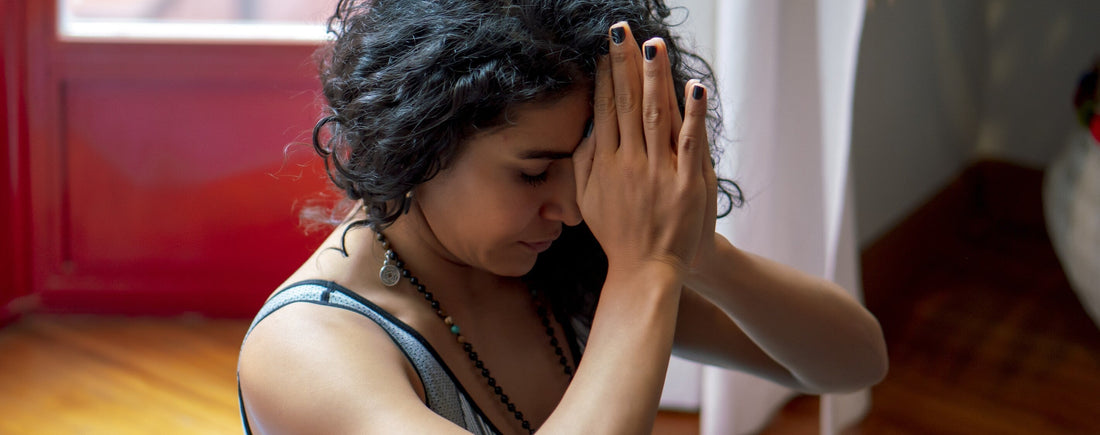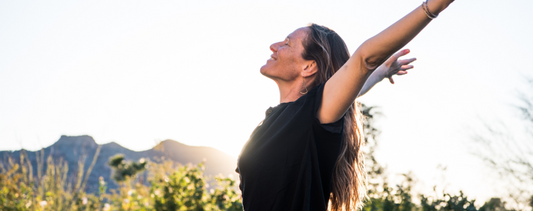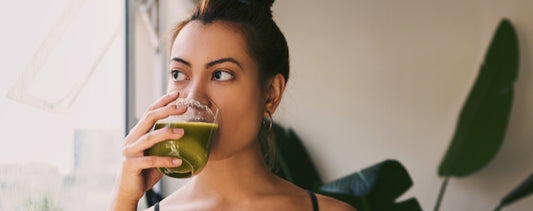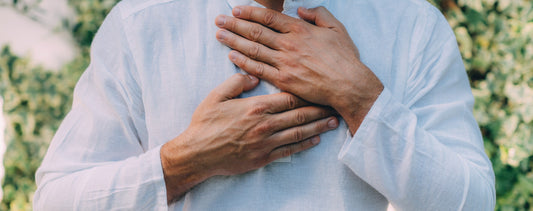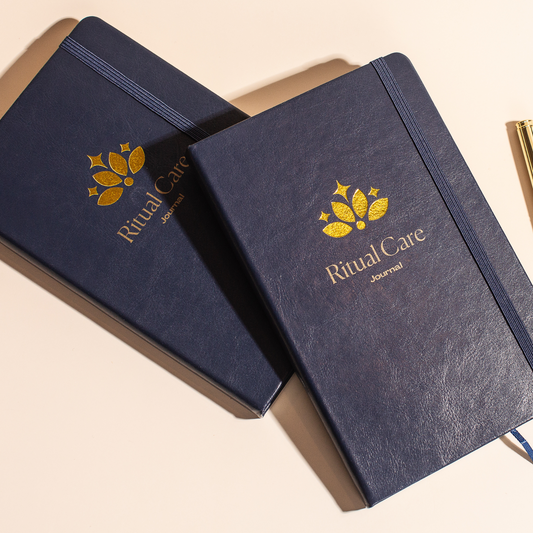In the U.S., Latinos tend to have stronger religious ties than most racial and ethnic groups. As such, faiths, largely Catholicism and Protestantism, often play a significant role in their lives, including the ways in which they cope with adversity. For some, healing comes solely through prayer and biblical scripture rather than traditional wellness practices like therapy and meditation, which are sometimes deemed blasphemous. While a shift is beginning to take place in how Latinos, including religious members of the community, view therapy, there still remains some skepticism and taboo around meditative practices.
Growing up, I was often told by my relatives that God was going to cure all my mental health troubles, then those challenges were just labeled “mentiras del diablo” or “lies of the devil.” When struggling with an eating disorder, my Pentecostal family urged me to pray and rebuke these demons from my life. When grappling with social anxiety, they often suggested that I turn to scripture to be reminded of my purpose and might through Jesucristo. The advice, while later acknowledged as being noncomprehensive, was always well meaning. My loving parents wanted the best for me—and were praying for my healing more than I was—but they had received messages throughout their lives that told them that anything that deviated from their faith, including science-backed therapy or ancient mindfulness practices, were ungodly and, thus, not an option. While their views have changed over the years, many in the Latino community continue to espouse these beliefs.
According to a 2019 study published in the journal Hispanic Health Care International, while Latinos report experiencing mental health issues at about the same rate as non-Latino whites, they are half as likely to seek treatment largely due to stigma-related culture and religion.
"Religious faith is an important source of strength for people who experience stress and mental illness," Susan Caplan, an assistant professor at the Rutgers School of Nursing and the author of the study, said. "But beliefs that mental illness is caused by sin or a lack of faith or that it can be cured by prayer alone can discourage people from seeking help, add to their suffering and even contribute to suicide."
While the notion that mental illnesses are influenced by evil spirits, or caused by a lack of faith remains among some, the rise in mental health awareness advocacy, and the increase of Latino clinicians, have helped to destigmatize therapy within the community, with more people—including elders who often hold onto these cultural misconceptions the longest—seeking professional help.
However, despite the ascending number of Latinos receiving mental health treatment, Yadira Enriquez, a Los Angeles-based therapist, says that she often still encounters hesitance or refusal from religious Latino patients when recommending mindfulness practices.
“When I was working in a clinic in the community here in East Los Angeles, where a lot of my patients were older señoras, I would see resistance to therapy but especially to mindfulness or any type of meditation because of their faith,” says Enriquez, who now owns and operates Evolution Counseling Service, a practice guided by intersectionality, including the ways race, ethnicity, class, gender, sexual orientation, ability, and religion are interlocked.
Explaining their resistance to these wellness customs, patients often told her: “I’m a person of faith,” “I go to church,” “The church doesn't approve of this,” “That’s not of God,” or “This isn’t in the Bible.”
Enriquez, who herself grew up in a Catholic, and later Pentecostal, home understands how these ideas, at first, could appear as an attack on their spirituality.
You’re in a religious faith that’s very black and white in its beliefs. Whether you’re Catholic or Protestant, the Bible is law, and no one questions it."
“You’re in a religious faith that’s very black and white in its beliefs. Whether you’re Catholic or Protestant, the Bible is law, and no one questions it,” she says. “... People are following these cultural practices and accepting everything they are consuming as absolute truth.”
While Enriquez ultimately respects her patients’ decisions, she sometimes responds to their religious justifications by reminding them of the Gospels of Matthew, Mark, and Luke, which detail the 40 days and 40 nights Jesus spent in the Judean Desert in solitude, prayer, and deep reflection.
“He was contemplating. He was in a reflective state. Essentially, this is what being mindful and meditation are all about,” Enriquez says.
Her parallels speak to the ways in which religious Latinos often practice wellness in their own ways and remind me of my own parents. While my father, for instance, might call me “foolish” for spending money on digital subscriptions for meditation apps, he has always given tithes and offerings to his church, where worship and sermons provide him with a sense of hope and peace. Similarly, although my mom is sometimes nervously confused when she spots me meditating, she, too, spends far more hours than I do in pensive solitude while praying and poring over scriptures.
Like my parents, many religious individuals exercise spiritual practices to cope with adversity or maintain a sense of calm. In a 1995 study of cancer patients published in the Journal of Psychosocial Oncology, Latinas were found to be more religious and more likely to obtain greater benefits from their spiritual coping strategies than non-Latina white women. In a similar study conducted in 2006 looking particularly at survivorship, Latinas shared that they believed their religion— including their faith in God and the support they received from several church members—played a role in the positive outcomes of their illnesses.
Similarly, several studies have found that mindfulness—which includes practices like meditation, sound baths, breathing exercises, and yoga—have also led to better health outcomes, physically, spiritually, and mentally.
“The way someone who identifies as a Christian prays can usually be described as a meditative state,” Enriquez says. “You are trying to pray to your creator, whoever that is to you, and that can essentially be the same as someone who is non-Christian but is practicing meditation in a different form and trying to get in touch with whatever it is they need to get in touch with: themselves [or] the universe.”
Identifying these connections helped psychologist J. Alexis Ortiz to encourage religious individuals to participate in her 2015 study about mindfulness-based stress reduction among Latinos. While one participant dropped out of her research project due to a perceived conflict with their denomination, after providing literature on faith-based meditation to the group, most of the members stayed on and some stated that they viewed mindfulness as a form of prayer.
For Enriquez, another approach to dispelling the myth that wellness practices are ungodly is by being a compassionate and respectful living example. Attempting to convince someone with deep-seated opposing ideas about mindfulness can be a losing battle. However, leading a life of wellness in front of loved ones while remaining humble, kind, and open to answering curious, or sometimes even brazen, inquiries helps normalize practices and makes them less taboo. This piqued interest and destigmatization might not prompt them to create a wellness routine that mirrors yours, but she says it can encourage them to prioritize their spiritual and mental health in new ways.
“It doesn’t have to be like what it looks like on TV, where people are in a contemplative state for 45 minutes. If that doesn’t work for you, that is OK. You can mold it into what helps you,” Enriquez says. “If you pray, then that’s your meditation. If you can only do simple stretches in the morning, then that is your yoga. If you do Zumba on the weekends, then that’s how you move your body.”
For me, wellness looks like both yoga and salsa classes."
For me, wellness looks like both yoga and salsa classes. It sounds like sound baths, worship music, and bass-thumping reggaetón parties. It smells like lavender oil and acrylic nail powder at my nail salon. It feels like serene monthly massages, morning meditations, and evening prayers. It tastes like a vegan diet that finds alternatives to the most delicious Puerto Rican dishes.
As Enriquez says, “We can use our bodies and our minds to engage with the universe or one’s creator in so many different ways.”
Growing up, I was often told by my relatives that God was going to cure all my mental health troubles, then those challenges were just labeled “mentiras del diablo” or “lies of the devil.” When struggling with an eating disorder, my Pentecostal family urged me to pray and rebuke these demons from my life. When grappling with social anxiety, they often suggested that I turn to scripture to be reminded of my purpose and might through Jesucristo. The advice, while later acknowledged as being noncomprehensive, was always well meaning. My loving parents wanted the best for me—and were praying for my healing more than I was—but they had received messages throughout their lives that told them that anything that deviated from their faith, including science-backed therapy or ancient mindfulness practices, were ungodly and, thus, not an option. While their views have changed over the years, many in the Latino community continue to espouse these beliefs.
According to a 2019 study published in the journal Hispanic Health Care International, while Latinos report experiencing mental health issues at about the same rate as non-Latino whites, they are half as likely to seek treatment largely due to stigma-related culture and religion.
Culture and Religion
"Religious faith is an important source of strength for people who experience stress and mental illness," Susan Caplan, an assistant professor at the Rutgers School of Nursing and the author of the study, said. "But beliefs that mental illness is caused by sin or a lack of faith or that it can be cured by prayer alone can discourage people from seeking help, add to their suffering and even contribute to suicide."
While the notion that mental illnesses are influenced by evil spirits, or caused by a lack of faith remains among some, the rise in mental health awareness advocacy, and the increase of Latino clinicians, have helped to destigmatize therapy within the community, with more people—including elders who often hold onto these cultural misconceptions the longest—seeking professional help.
However, despite the ascending number of Latinos receiving mental health treatment, Yadira Enriquez, a Los Angeles-based therapist, says that she often still encounters hesitance or refusal from religious Latino patients when recommending mindfulness practices.
“When I was working in a clinic in the community here in East Los Angeles, where a lot of my patients were older señoras, I would see resistance to therapy but especially to mindfulness or any type of meditation because of their faith,” says Enriquez, who now owns and operates Evolution Counseling Service, a practice guided by intersectionality, including the ways race, ethnicity, class, gender, sexual orientation, ability, and religion are interlocked.
Explaining their resistance to these wellness customs, patients often told her: “I’m a person of faith,” “I go to church,” “The church doesn't approve of this,” “That’s not of God,” or “This isn’t in the Bible.”
Enriquez, who herself grew up in a Catholic, and later Pentecostal, home understands how these ideas, at first, could appear as an attack on their spirituality.
“You’re in a religious faith that’s very black and white in its beliefs. Whether you’re Catholic or Protestant, the Bible is law, and no one questions it,” she says. “... People are following these cultural practices and accepting everything they are consuming as absolute truth.”
While Enriquez ultimately respects her patients’ decisions, she sometimes responds to their religious justifications by reminding them of the Gospels of Matthew, Mark, and Luke, which detail the 40 days and 40 nights Jesus spent in the Judean Desert in solitude, prayer, and deep reflection.
“He was contemplating. He was in a reflective state. Essentially, this is what being mindful and meditation are all about,” Enriquez says.
Her parallels speak to the ways in which religious Latinos often practice wellness in their own ways and remind me of my own parents. While my father, for instance, might call me “foolish” for spending money on digital subscriptions for meditation apps, he has always given tithes and offerings to his church, where worship and sermons provide him with a sense of hope and peace. Similarly, although my mom is sometimes nervously confused when she spots me meditating, she, too, spends far more hours than I do in pensive solitude while praying and poring over scriptures.
Like my parents, many religious individuals exercise spiritual practices to cope with adversity or maintain a sense of calm. In a 1995 study of cancer patients published in the Journal of Psychosocial Oncology, Latinas were found to be more religious and more likely to obtain greater benefits from their spiritual coping strategies than non-Latina white women. In a similar study conducted in 2006 looking particularly at survivorship, Latinas shared that they believed their religion— including their faith in God and the support they received from several church members—played a role in the positive outcomes of their illnesses.
Similarly, several studies have found that mindfulness—which includes practices like meditation, sound baths, breathing exercises, and yoga—have also led to better health outcomes, physically, spiritually, and mentally.
“The way someone who identifies as a Christian prays can usually be described as a meditative state,” Enriquez says. “You are trying to pray to your creator, whoever that is to you, and that can essentially be the same as someone who is non-Christian but is practicing meditation in a different form and trying to get in touch with whatever it is they need to get in touch with: themselves [or] the universe.”
Identifying these connections helped psychologist J. Alexis Ortiz to encourage religious individuals to participate in her 2015 study about mindfulness-based stress reduction among Latinos. While one participant dropped out of her research project due to a perceived conflict with their denomination, after providing literature on faith-based meditation to the group, most of the members stayed on and some stated that they viewed mindfulness as a form of prayer.
For Enriquez, another approach to dispelling the myth that wellness practices are ungodly is by being a compassionate and respectful living example. Attempting to convince someone with deep-seated opposing ideas about mindfulness can be a losing battle. However, leading a life of wellness in front of loved ones while remaining humble, kind, and open to answering curious, or sometimes even brazen, inquiries helps normalize practices and makes them less taboo. This piqued interest and destigmatization might not prompt them to create a wellness routine that mirrors yours, but she says it can encourage them to prioritize their spiritual and mental health in new ways.
“It doesn’t have to be like what it looks like on TV, where people are in a contemplative state for 45 minutes. If that doesn’t work for you, that is OK. You can mold it into what helps you,” Enriquez says. “If you pray, then that’s your meditation. If you can only do simple stretches in the morning, then that is your yoga. If you do Zumba on the weekends, then that’s how you move your body.”
For me, wellness looks like both yoga and salsa classes. It sounds like sound baths, worship music, and bass-thumping reggaetón parties. It smells like lavender oil and acrylic nail powder at my nail salon. It feels like serene monthly massages, morning meditations, and evening prayers. It tastes like a vegan diet that finds alternatives to the most delicious Puerto Rican dishes.
As Enriquez says, “We can use our bodies and our minds to engage with the universe or one’s creator in so many different ways.”

